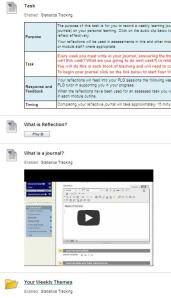Two questions asked in the survey aimed to find out what benefits participants perceived by taking part in SPEED. The questions are:
- What did you like most about the SPEED course?
- What were the key things you learnt on the SPEED course?
Data gathered from the survey indicated two areas that participants have benefitted a lot:
- Promoting sharing, discussing, debating, and collaborating
- Accessing activities, tools and resources that can be applied in practice to improve student online experience.
In this blog, I will report on the first benefit – promote sharing, discussing, debating, and collaborating.
The quantitative data from the survey shows that SPEED has enabled participants to interact and collaborate with colleagues from other partner institutions via a number of ways: webinars, CourseSites, email, and phone (see table below).
| In what ways did you interact with colleagues from other partner institutions during SPEED? |
No. of participants
|
| Via the CourseSites VLE |
7
|
| Via the Webinars |
10
|
| Via e-mail |
5
|
| Via phone |
5
|
| Via others |
1
|
The qualitative data collected from the survey reinforced this point. All respondents appreciated and valued the opportunities of being able to share, collaborate, discuss and debate ideas with colleagues from other institutions during SPEED. Some quotes are illustrated below:
- “Collaborating with other institutions; working with like-minded colleagues who enjoy online work. (P3)
- “Ability to interact and learn from other colleagues.” (P4)
- “It has been good to listen to the experience of partner institutions and share experience of developing resources differently.” (P5)
- “Sharing practice and listening to others experiences.” (P7)
- “Stimulating and open conversations about working in teaching and learning in HE.” (P8)
- “It provided an opportunity to discuss aspects of e-learning and an opportunity to try some e-tivities… Gave me an opportunity to engage with the Learning Technology Staff. To share concepts and debate concepts of e-learning with people outside my institution.” (P9)
- Interesting and engaging collaborators. (P10)
The webinars were found most engaging in maintaining participants’ interest in the course, and stimulating discussion and sharing. Relevant quotes are given as follows:
- “I found the webinars most useful and enjoyed the discussion with other colleagues in different universities.” (P1)
- “The webinars helped me hear about new practices and develop ideas.” (P2)
- “The face-to-face workshop was a good introduction and the webinars maintained interest and motivation in SPEED activities.” (P5)
- “I really enjoyed the course, especially sharing ideas via the Webinar.” (P9)
Opportunities for sharing, debating and collaborating enabled participants to develop a deeper understanding of e-learning and online learning, as one respondent concluded: “It has raised my awareness of online learning.”
In the next blog, I will discuss findings around the second benefit – access to useful activities, tools and resources.
